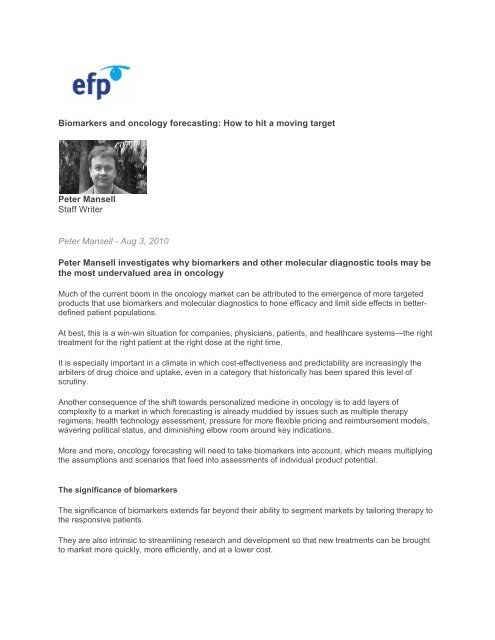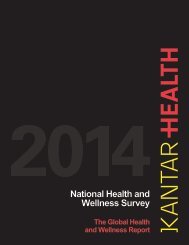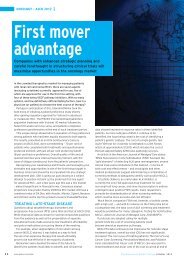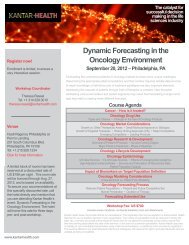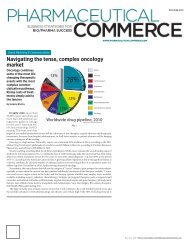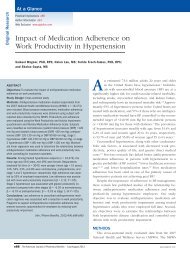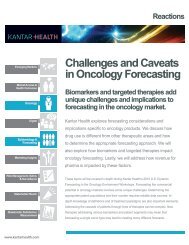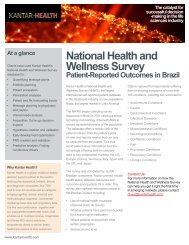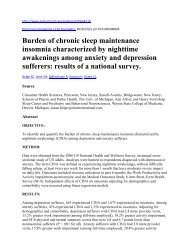Biomarkers and oncology forecasting: How to hit a ... - Kantar Health
Biomarkers and oncology forecasting: How to hit a ... - Kantar Health
Biomarkers and oncology forecasting: How to hit a ... - Kantar Health
Create successful ePaper yourself
Turn your PDF publications into a flip-book with our unique Google optimized e-Paper software.
<strong>Biomarkers</strong> <strong>and</strong> <strong>oncology</strong> <strong>forecasting</strong>: <strong>How</strong> <strong>to</strong> <strong>hit</strong> a moving targetPeter MansellStaff WriterPeter Mansell - Aug 3, 2010Peter Mansell investigates why biomarkers <strong>and</strong> other molecular diagnostic <strong>to</strong>ols may bethe most undervalued area in <strong>oncology</strong>Much of the current boom in the <strong>oncology</strong> market can be attributed <strong>to</strong> the emergence of more targetedproducts that use biomarkers <strong>and</strong> molecular diagnostics <strong>to</strong> hone efficacy <strong>and</strong> limit side effects in betterdefinedpatient populations.At best, this is a win-win situation for companies, physicians, patients, <strong>and</strong> healthcare systems—the righttreatment for the right patient at the right dose at the right time.It is especially important in a climate in which cost-effectiveness <strong>and</strong> predictability are increasingly thearbiters of drug choice <strong>and</strong> uptake, even in a category that his<strong>to</strong>rically has been spared this level ofscrutiny.Another consequence of the shift <strong>to</strong>wards personalized medicine in <strong>oncology</strong> is <strong>to</strong> add layers ofcomplexity <strong>to</strong> a market in which <strong>forecasting</strong> is already muddied by issues such as multiple therapyregimens, health technology assessment, pressure for more flexible pricing <strong>and</strong> reimbursement models,wavering political status, <strong>and</strong> diminishing elbow room around key indications.More <strong>and</strong> more, <strong>oncology</strong> <strong>forecasting</strong> will need <strong>to</strong> take biomarkers in<strong>to</strong> account, which means multiplyingthe assumptions <strong>and</strong> scenarios that feed in<strong>to</strong> assessments of individual product potential.The significance of biomarkersThe significance of biomarkers extends far beyond their ability <strong>to</strong> segment markets by tailoring therapy <strong>to</strong>the responsive patients.They are also intrinsic <strong>to</strong> streamlining research <strong>and</strong> development so that new treatments can be brought<strong>to</strong> market more quickly, more efficiently, <strong>and</strong> at a lower cost.
2Despite the availability of high-profile targeted anticancers such as Gleevec (imatinib) or Herceptin(trastuzumab), drug development in <strong>oncology</strong> “remains painfully slow,” note Eric Groves, Jason Hill, <strong>and</strong>Chris<strong>to</strong>pher Ung of Quintiles in a recent w<strong>hit</strong>e paper.Only 8% of new molecular entities in <strong>oncology</strong> make it <strong>to</strong> market <strong>and</strong> late-stage failures are common, withapproximately six out of ten drugs in development falling by the wayside in Phase III trials.Stripping out some of that risk calls for <strong>to</strong>ols that can elucidate a drug’s mechanism of action <strong>and</strong> steerselection of the most appropriate patients <strong>to</strong> enrich the clinical study population, mitigate risks <strong>to</strong> nonresponders,<strong>and</strong> facilitate earlier assessment of efficacy.As the Quintiles executives point out, over the past two decades molecular biomarkers have “becomeestablished components of clinical research in a way few could have foreseen.”At the same time, this rapid evolution is reshaping clinical practice <strong>and</strong> the <strong>oncology</strong> marketplace.“Now a particular tumor type is no longer classified by its his<strong>to</strong>logical properties alone,” Groves, Hill, <strong>and</strong>Ung comment.<strong>Biomarkers</strong> are increasingly used <strong>to</strong> segment tumor types by molecular profile.“So, for example, breast cancer is now recognized as containing luminal A, luminal B, basal type, erbB2,<strong>and</strong> triple negative sub-populations, each of which have a different management strategy, <strong>and</strong> vary inpatient prognoses <strong>and</strong> therapy response characteristics.”The end result is that marketed <strong>oncology</strong> products “live in an environment where the market’s size (targetpopulation) is continually being affected by evolving patient selection biomarkers, <strong>and</strong> these effects on thepotential use <strong>and</strong> sales of a drug can be large,” the w<strong>hit</strong>e paper authors add.The most undervalued area in <strong>oncology</strong>Karol Sikora, medical direc<strong>to</strong>r of CancerPartnersUK, sees biomarkers <strong>and</strong> other molecular diagnostics asthe most undervalued area in a category heading for meltdown under the competing pressures of costcontainment, ageing populations, earlier intervention, an explosion of new <strong>and</strong> expensive therapies, moreaggressive patient expectations <strong>and</strong> advocacy, <strong>and</strong> hard questions about the real value of incrementalsurvival benefits. (For more on <strong>forecasting</strong> challenges, see ‘Forecasting for complex diseases’.)These <strong>to</strong>ols can radically alter the cost-effectiveness ratio for cancer therapies <strong>and</strong>, in doing so, addressstakeholders concerns across the board, Sikora believes.By 2020, Sikora foresees at worst risk prediction in small patient subsets <strong>and</strong> at best population riskb<strong>and</strong>ing for cancer.Micro-b<strong>and</strong>s will reclassify cancers by targeting specific disease pathways.There could even be routine molecular phenotyping before prescribing decisions are taken.That means overhauling pharmaceutical industry strategy in the category, Sikora <strong>to</strong>ld eyeforpharma’srecent Oncology Market Access Europe 2010 Summit in London.<strong>Biomarkers</strong> <strong>and</strong> <strong>oncology</strong> <strong>forecasting</strong>: <strong>How</strong> <strong>to</strong> <strong>hit</strong> a moving target, eyeforpharma
3In the 1990s, it was all about being first in class, achieving market leadership with one or two indications,<strong>and</strong> spinning it out through lifestyle management.The next 10 years will require a “more subtle” approach, with companion diagnostics segmenting themarket <strong>and</strong> driving new line extensions, Sikora predicted.As things st<strong>and</strong>, the pool of <strong>oncology</strong> products with associated biomarkers is still “relatively small” interms of patient numbers, notes Dr Robert Ramsey, vice president <strong>and</strong> chief scientific officer of <strong>Kantar</strong><strong>Health</strong>.Where biomarkers have become part of st<strong>and</strong>ard care, though, such as in breast or colorectal cancer, theimpact is substantial.And in a comparatively minor indication like chronic myelogenous leukemia, the effect of targeting therapyat the BCR/ABL biomarker (Gleevec) has been <strong>to</strong> extend lifespans from around six months <strong>to</strong> six orseven years, Ramsey points out.Moreover, most of the emphasis in <strong>oncology</strong> drug development is now moving away from what Ramseycalls the “blunderbuss” approach <strong>to</strong>wards more tailored therapies.Targeted biomarkers include mutations of the B-RAF gene (melanoma <strong>and</strong> colorectal cancer), of EML4-ALK (non-small cell lung cancer), FLT-3 (acute myeloid leukaemia) <strong>and</strong> BRAC 1/2 (variety of tumours).(For more on the related area of biosimilars, see ‘Forecasting the future of biosimilars’.)Biomarker developmentTo date, though, biomarker development has generally been “<strong>hit</strong> <strong>and</strong> miss,” Ramsey acknowledges.“We don’t know enough about the biology of these drugs <strong>and</strong> what they’re affecting early on in clinicaldevelopment <strong>to</strong> know where we should look for biomarkers.”If a drug is targeted at a genetic mutation, it should be detectable, he adds.But with biomarkers such as HER2 (Herceptin) or oestrogen recep<strong>to</strong>rs (tamoxifen, aromatase inhibi<strong>to</strong>rs),“We’re not aiming just at a mutation, we’re looking at some other aberration in terms of metabolism.”As Ramsey explains, a biomarker such as HER2 provides a measurement along a continuum, rather thana simple yes/no answer—as with K-RAS (Erbitux) or EGFR (Iressa) mutations.Consequently, there needs <strong>to</strong> be cut-off points indicating a positive result, <strong>and</strong> so far these have been set“arbitrarily.”Even with a yes/no biomarker, where the objective is <strong>to</strong> determine the presence or absence of mutations,there are complications.For example, Ramsey notes, tumors are by nature heterogeneous.So if a biomarker test yields a positive mutation, that raises the question of what proportion of cells in thetumor a positive measure actually represents.<strong>Biomarkers</strong> <strong>and</strong> <strong>oncology</strong> <strong>forecasting</strong>: <strong>How</strong> <strong>to</strong> <strong>hit</strong> a moving target, eyeforpharma


